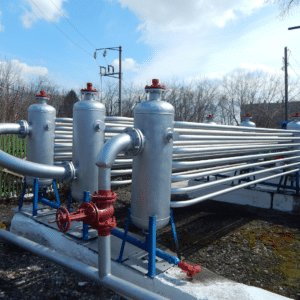Fire suppression systems are usually out of sight, out of mind until they spring to action during a fire. Our Miami fire suppression company wants to share the superhero powers of these life-saving systems so that you’ll appreciate their incredible impact.
No Fire & Life Safety strategy is complete without a fire suppression system. These essential yet often overlooked fire safety components save lives and protect property during fire emergencies. Our Miami fire suppression company explores fire suppression systems’ practical significance and life-saving capabilities, shedding light on their indispensable contribution to fire safety protocols.
Fire Suppression Starts With Sprinklers
The most common type of fire suppression is a wet fire sprinkler system. These systems are widely used because of their ease of installation and operation. Dry sprinklers, pre-action, and deluge systems round out the water fire sprinkler category. Let’s deep dive into their life-saving operation.
Wet Pipe – Water stays in the pipes of a wet fire sprinkler system and is dispensed immediately when a fire is detected. Wet sprinkler systems are ideal for facilities that house Class A fire hazards like paper, plastics, wood, and cloth. Most businesses and residential buildings are equipped with a wet pipe sprinkler system.
Dry Pipe – These systems use pressurized air or nitrogen to keep water out of the pipes until a fire triggers the sprinklers. They’re ideal for museums, data centers, or libraries, where minimizing water damage is crucial. These systems protect sensitive equipment and valuable assets by suppressing fires without immediate water release, reducing potential damage to irreplaceable artifacts.
Pre-Action – Pre-action sprinkler systems require a two-step process before activation. Initially, a fire detection system identifies the presence of a fire. Then, the pre-action valve opens to allow water into the pipes. Only when a sprinkler head is individually activated by heat does water discharge onto the fire area. This two-step process helps prevent accidental water discharge, protecting against water damage in sensitive environments.
Deluge – A deluge system uses open nozzles and a rapid release of a large volume of water simultaneously upon system activation. This system is critical in hazardous environments where fire can spread rapidly, such as industrial settings with flammable liquids or areas prone to high-risk fires. The immediate and intense water discharge helps swiftly suppress and contain fires, contributing to life-saving measures by quickly controlling fire escalation in these challenging and potentially dangerous environments.
Waterless Fire Suppression Systems
Some commercial properties, like data centers, museums, or areas housing sensitive equipment, opt for waterless fire suppression systems to mitigate potential damage. These systems use agents like inert gases or chemical agents, as water could harm or destroy delicate equipment, data, or high-value assets.
By employing waterless systems, these properties ensure effective fire suppression without causing additional harm or loss, thus contributing to life-saving efforts by safeguarding critical assets and minimizing potential hazards during fire incidents. Let’s explore a few of these water-free fire suppression systems.
Foam – A foam fire suppression system uses foam agents to extinguish fires by blanketing the area and suppressing the flames. These systems are commonly used in areas with flammable liquids, such as fuel storage facilities or hangars, as the foam forms a barrier that cuts off the fire’s oxygen supply. Foam systems effectively smother and quickly suppress fires involving flammable liquids, making them valuable in containing such hazards before they get out of control.
liquids, such as fuel storage facilities or hangars, as the foam forms a barrier that cuts off the fire’s oxygen supply. Foam systems effectively smother and quickly suppress fires involving flammable liquids, making them valuable in containing such hazards before they get out of control.
Inert Gas – An inert gas fire suppression system uses nitrogen, argon, or carbon dioxide to extinguish fires by reducing the oxygen concentration to a level where combustion can’t be sustained. Using a fire suppression system that does not leave residue helps protect the integrity of equipment and minimizes downtime for critical operations.
Clean Agent – A clean agent fire suppression system uses chemical agents like FM-200, Novec 1230, or CO2 to rapidly extinguish fires while leaving no residue or damage to protected assets. These systems are ideal for spaces containing delicate electronics, data storage, or irreplaceable assets, as they offer effective fire suppression without causing harm to sensitive materials or requiring extensive cleanup after a fire event.
Both inert gas and clean agent systems effectively safeguard spaces with sensitive equipment. However, they use different agents or gases to put out fires, depending on what suits the protected area and the type of fire. Our Miami fire suppression company can help you choose the right fire suppression agent for your facility.
DynaFire Is The Miami Fire Suppression Company For All Of Your Fire Suppression Needs
Regardless of the type of facility you manage, DynaFire is your one-stop shop for all things Fire & Life Safety. We can assess your fire suppression needs, design and install your customized system, and maintain it for optimal operation. Contact us today to see how our fire suppression systems can work to keep your building occupants and your business safe.






